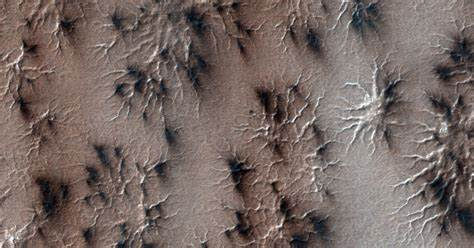
NASA reported that it had been able to decipher the origin of Mars spiders, unusual formations that extend across the surface of several regions in the southern hemisphere of the red planet.
Since their discovery in 2003, researchers have been fascinated by these spider-like branching structures, each measuring up to a kilometre wide. These geological formations, known scientifically as araneiform soils, are closely grouped, which causes the Martian soil to look wrinkled.
Initially, scientists theorized that these arachnids formed as a result of the sudden sublimation of carbon dioxide (CO2) ice found on the planet’s surface.
In an attempt to test this hypothesis, an international group of researchers decided to recreate the process of sublimation of CO2 ice, which does not occur naturally on Earth, in a specialized laboratory chamber. This device, called DUSTIE, has the ability to produce conditions similar to Mars' atmospheric temperatures and pressures.
A study, recently published in The Planetary Science Journal, reported that for the first time it was possible to imitate Martian spiders and test the idea of their formation.
How did these spiders form?
The research authors explained the stages that give rise to these structures. First, CO2 ice sheets accumulate on the Martian surface during the winter. Later, when spring comes to Mars, the light from the Sun reaches frozen CO2, which turns it into gas.
This CO2 is released from the soil due to cracking caused by increased pressure of this gas. Once it leaves the surface, CO2 drags dark dust and sand from the ground, creating Martian spiders. Recreating the process in the laboratory
After producing CO2 ice, the scientists placed a heater inside the DUSTIE with the purpose of raising its temperature and breaking it. Finally, they observed a column of CO2 gas emerging from the simulated Martian soil. These gas columns opened holes as they escaped, causing cracks in the ground to appear that resemble Martian spiders.
Experts mentioned that they plan to conduct more similar experiments to find out why spiders are forming at certain places on Mars and why they do not seem to be increasing in size over time. (Text and photo: RT)